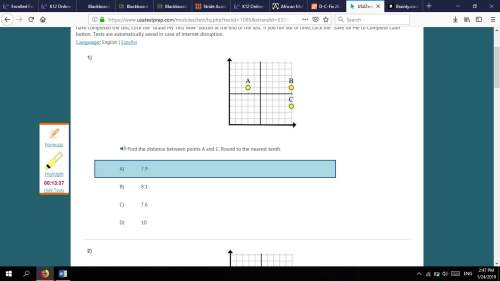
Mathematics, 24.01.2022 14:00 rachelreed
Jim and Maria run a city relay race. The race consists of
8 laps around a planned city route. Jim runs 3 of the laps
at an average speed that is 0.5 mile per hour faster than
Maria's average speed for the remaining 5 laps. What is
Jim and Maria's combined race time? Let r represent
Maria's average speed.

Answers: 1


Another question on Mathematics

Mathematics, 21.06.2019 14:00
Me. drysdale earned 906.25 in interest in one year on money that he had deposited in his local bank if the bank paid an interest rate of 6.25% how much money did mr. drysdale deposit
Answers: 2

Mathematics, 21.06.2019 15:00
Saline iv fluid bags cost $64.20 for 24, 1000 ml bags from one supplier. another supplier sells 500 ml bags for $2 each. the hospital uses about 10,000, 1000 ml bags each month. nurses report that about half of the bags are more than half full when they are discarded. if you are going to use only one supplier, which would you choose and how much would you save with that choice? show calculator try it! if you buy 1000 ml bags, how many do you need to buy each month? type your answer in the space provided and click on the check answer button.
Answers: 3

Mathematics, 21.06.2019 16:00
Martin likes to make flower bouquets that have 3 daffodils and 4 tulips per vase. a daffodil has a mass of d grams, a tulip has a mass of t grams, and the vase has a mass of u grams. the expression 5(3d + 4t + v) describes the mass of 5 bouquets. match each amount in the situation with the expression that represents it. situation expression number of bouquets mass of one bouquet mass of the tulips in one bouquet 4t mass of the daffodils in one bouquet 3d + 4t + v
Answers: 2

Mathematics, 21.06.2019 17:00
In tossing one coin 10 times, what are your chances for tossing a head? a tail? 2. in tossing one coin 100 times, what are your chances for tossing a head? a tail? 3. in tossing one coin 200 times, what are your chances for tossing a head? a tail? deviation = ((absolute value of the difference between expected heads and observed heads) + (absolute value of the difference between expected tails and observed tails)) divided by total number of tosses. this value should always be positive. 4. what is the deviation for 10 tosses? 5. what is the deviation for the 100 tosses? 6. what is the deviation for 200 tosses? 7. how does increasing the total number of coin tosses from 10 to 100 affect the deviation? 8. how does increasing the total number of tosses from 100 to 200 affect the deviation? 9. what two important probability principles were established in this exercise? 10. the percent of occurrence is the obtained results divided by the total tosses and multiplied by 100%. toss the coins 100 times and record your results. calculate the percent occurrence for each combination. percent head-head occurrence: percent tail-tail occurrence: percent head-tail occurrence:
Answers: 3
You know the right answer?
Jim and Maria run a city relay race. The race consists of
8 laps around a planned city route. Jim...
Questions

Mathematics, 19.04.2021 18:30


Mathematics, 19.04.2021 18:30

English, 19.04.2021 18:30



Spanish, 19.04.2021 18:30



English, 19.04.2021 18:30



Chemistry, 19.04.2021 18:30



Mathematics, 19.04.2021 18:30

Mathematics, 19.04.2021 18:30


Health, 19.04.2021 18:30

Mathematics, 19.04.2021 18:30




